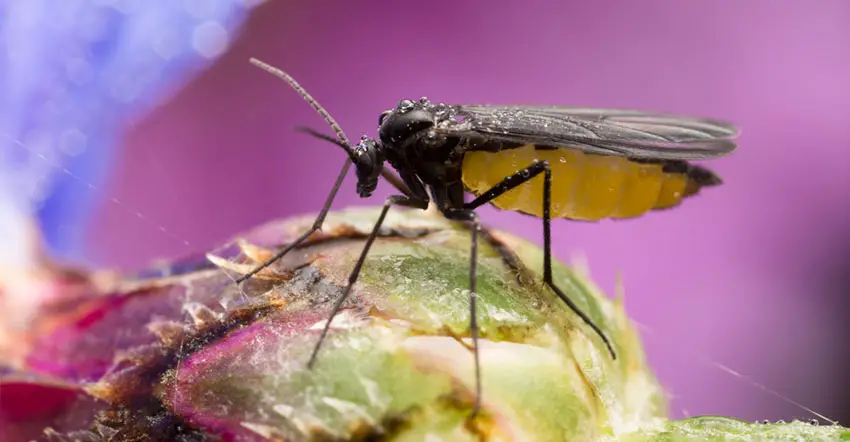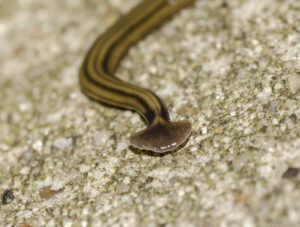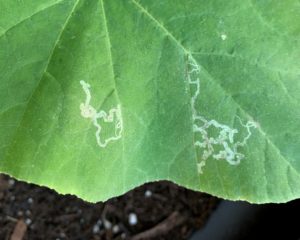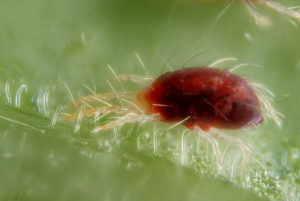One of the most annoying insects on the planet is the fungus gnat. These tiny flying insects are usually associated with indoor houseplants. But for those of us who grow vegetables or who start seeds indoors, they can be just as bothersome. Not only are they a nuisance, but the larvae also eat the plant roots which can harm and ultimately kill the plant or seedling.
What Are Fungus Gnats?
Fungus gnats, also called soil gnats, are tiny flying insects that measure between 2.5 and 3 mm long. They have grey-black bodies, segmented antennae, slender legs, black heads, and clear wings. They are sometimes confused with mosquitoes although they are much smaller and they do not sting. Fungus gnats are so named because they feed on fungi growing in plant soil.
A female fungus gnat lays up to 300 white-yellow eggs in damp soil or organic matter during her one week life span. If the temperature is at least 75o F or more (24o C), the eggs will hatch in about three days. The larvae look like small worms with translucent bodies and black heads. They feed on fungus and any decaying matter found in the soil, including roots. After about two weeks, they pupate. Four days later their transformation to an adult fungus gnat is complete. The life cycle can be suspended for a period of time if temperature is not conducive to development.
Where Do Fungus Gnats Come From?
Fungus gnats live in damp soil or other moist organic matter. They can be very stealth when it comes to gaining access to your home through tiny cracks, or open doors and windows. But another way they enter your home is in the soil of plants you have purchased at the nursery or received as a gift. For that reason, you should always inspect new plants for fungus gnats, spider mites, and other insects before purchasing them or bringing them into your home or garden. It is a good idea to isolate a new plant before placing it next to other plants you already have because if there are fungus gnats (in any stage) the chances of them spreading to your other plants will be minimized.
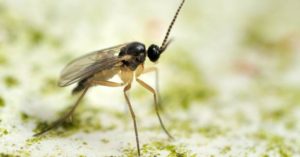
For those who start seeds indoors, fungus gnat eggs can be hiding in the potting mix or other plant medium you use to plant seeds. Bags of soil, peat moss, potting mix, etc. are often stored outdoors at garden centers or your home where they are exposed to rain and possibly moisture from irrigation systems. If you have ever opened up a bag of potting mix and found it damp then you know what I mean. Even dry potting mix can harbor eggs that will hatch once water is added.
This article contains affiliate links. If you make a purchase using one of these links, I will receive a very small commission at no additional cost to you, and it will help me maintain this website. Rest assured, I only recommend products I actually like!
As a preventative measure, some recommend sterilizing potting mix by hydrating it with boiling water so as to kill any eggs or larvae that may be lurking in it. Once completely cooled, it is used to start seeds or repot plants. The problem with this method is that the boiling water will kill the beneficial micro-organisms that live in the soil. It is possible to add micro-organisms back into the soil with products like Dr. Earth, but you will need to decide if this is something you are willing to do.
Treatment Methods
Because fungus gnats multiply rapidly, the problem can get out of hand rather quickly. Therefore, it is important to begin treatment as soon as you see one around your seedlings or plants. If there is one, there are bound to be more. Here is a list of treatment methods. You will need to implement more than one method since they target various stages of the fungus gnat life cycle. The treatment options work with household plants, garden plants, or seedlings. It may take several weeks or more for the treatment to be successful, depending on the level of infestation. Fungus gnats are relentless so you will have to be, too.
1. Allow the soil to dry – Let the top one to two inches of soil dry out. This will discourage adult gnats from laying their eggs and possibly hinder any eggs or larvae that are present, but unseen, in the soil.
2. Water sparingly from below – During the treatment phase especially, water plants sparingly so as not to recreate a moist environment. If possible, water from below, but do not allow standing water to remain as fungus gnats will be attracted to it.
3. Neem oil, with the naturally occurring Azadirachtin, can be a very effective treatment for fungus gnats. The oil disrupts the fungus gnat’s development in the egg, larva, and pupa stages, and acts as a deterrent to the adults. Add one teaspoon of cold pressed neem oil (check the label to make sure it contains Azadirachtin) and 1/2 teaspoon of chemical-free soap like Castile soap, to 16 ounces of water. Do a test spray and wait 24-48 hours to see if there are any adverse reactions. If the plant seems distressed, dilute the mixture and perform another test. Spray the soil’s surface thoroughly. You will also need to spray the exterior sides and bottom of the container where they like to hide. You will probably need to place the plant inside a tray or plant saucer to catch any run off. Repeat the process every three days for four to five weeks, which is the length of the life cycle. You must be consistent. If you are starting seeds, spray the neem oil and soap mixture on the inside and outside of the plant tray and seedling pots as part of a preventative measure.
4. Hydrogen peroxide is an antifungal that helps kill the fungus that the gnats feed on. It also kills the larvae in the soil. Use the 3% hydrogen peroxide commonly found in grocery stores or pharmacies. The hydrogen peroxide will break down into oxygen and water molecules, both of which are harmless unless the solution is too concentrated (greater than 1:4 ratio) or applied too frequently in which case it can burn the foliage, especially young plants and seedlings. Do a test spray as a precaution before applying and monitor plant health during the process.
Allow the top inch of the soil to dry out. Then water the plant with a mixture of one part hydrogen peroxide and four parts water. Allow the mixture to drain out and then discard. You can also apply this mixture to the soil using a spray bottle. Repeat until there are no signs of fungus gnats. The process could take several weeks.
5. Apple Cider Vinegar (ACV), which is fermented, works well as a trap for the adult fungus gnats because they are attracted to anything that is decomposing or fermenting. Fill a shallow bowl, dish or lid 3/4 of the way with ACV. Add a drop or two of dish soap which will help break the surface tension of the liquid and make it difficult for the fungus gnats to get out once they land on the ACV. Place the traps in and around the plants. You will need to monitor the traps because the liquid will evaporate, especially if placed under grow lights, rendering the traps ineffective. So keep the traps filled and be patient.
Some recommend placing plastic wrap over the container and punching small holes in it for access points. The plastic is what traps the gnats and keeps them from flying away. But the addition of dish soap makes this unnecessary, and the plastic wrap limits their access to the ACV.
6. Sticky traps are another way to trap adult fungus gnats. The yellow traps, which are said to attract the gnats, are coated with a sticky residue that makes it impossible for the gnats to fly away once they have landed on them. But this advantage can also be a slight down fall. The traps are so sticky that plant leaves, etc. sometimes get caught on them, too. For this reason, you may want to use the smaller sized traps, especially if deploying around seedlings.
7. Potato slices – According to Whitney Cranshaw of Colorado State University, you can use 1/4 inch slices of raw potato placed on the surface of the soil to detect fungus gnat larvae.[1] Within a few days, the slices will contain tiny larvae. Some recommend using small chunks of raw potato and checking every three to four hours for larvae. Replace potato slices or chunks when larvae are detected and dispose of them in a sealed bag in the trash.
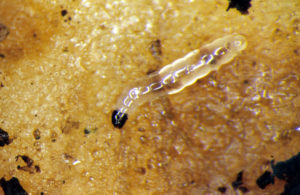
8. Cinnamon is well-known for its anti-fungal properties. Since fungus gnats feed on fungus, a sprinkling of cinnamon on the soil can help deter fungal growth. This does not kill fungus gnats but it helps to eliminate their favorite food source and the scent serves as a deterrent.
9. Repot – If the infestation is extreme, consider repotting the plant in fresh soil. If possible, go outside to make the transfer so that any adult fungus gnats, eggs or larvae that are displaced during the process will not be released in your home or greenhouse. Throw the old soil away, do not compost it. Wash any tools you used with a 1:10 bleach-water mixture that will kill eggs and larvae. Adult fungus gnats will probably still be in your home so you may need to treat the new soil with neem oil-soap spray (see above) to make it an inhospitable environment.
What about Mosquito Bits?
Some recommend a product called Mosquito Bits, which is now labeled as effective, not only against mosquitoes, but also fungus gnats. One drawback that is frequently reported by those who use Mosquito Bits is that the bits get moldy and must be picked out of the soil and disposed of. But for some who are considering using this product on edible plants, this is not the only concern.
The main ingredient in Mosquito Bits is BTi or Bacillus Thuringiensis Isrealensis, a strain of naturally occurring soil bacteria that was first discovered in Israel in 1977[2]. It is related to the more well-known Bacillus Thuringiensis BT. BTi works by producing toxins that affect the stomach lining of the mosquito, black fly, and fungus gnat larvae, which ultimately results in their death. BTi is said not to affect other insects or mammals because the toxin is activated by the alkaline environment found in the targeted species’ digestive system.[3] The manufacturer of Mosquito Bits, however, includes a extremely serious health warning on the package label that includes, in part, a directive to avoid ingesting the product or inhaling its dust, getting it into your eyes, and to call poison control if this occurs or if the product touches your skin or clothes. There are environmental warnings included as well. It has been noted that products with BTi are required by law to carry warning and cautionary labels because it is a registered pesticide.[4]
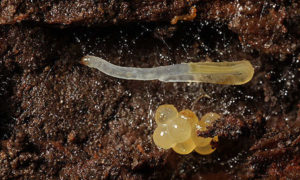
The EPA Fact Sheet on BTi states there is no health risk to humans if the directions are followed, and that it can be used in organic gardening.[5] Nevertheless, there have been serious questions raised by some scientific studies done in rats, mice, beneficial insects, tadpoles, minnows, and the environment regarding this position.[6],[7],[8]
While BTi may be considered safe by many, it only accounts for roughly 3% of the ingredients in Mosquito Bits. The remaining 97% are not listed by the manufacturer and therefore cannot be evaluated for safety. Regarding BTi formulations and secondary or inert ingredients, one state health department admitted that it is possible for some individuals to be more sensitive to certain other ingredients. For this reason, they recommend that people “minimize direct exposure to BTi as much as possible.”[9]
Mosquito Bits could be perfectly safe to use on non-edible houseplants as long as directions are followed, but should you use it on vegetable or other edible plants? That is a question you will have to answer for yourself. As for me, I still have some concerns. Therefore, I have decided to refrain from using products containing BTi because there are other safe and effective methods available to get rid of fungus gnats.
Fungus gnats may be a nuisance to humans and pets and detrimental to the health of your plants, but they don’t have to ruin your gardening experience. The secret to eliminating them is to monitor your watering practices and consistently apply multiple treatment methods until the problem is resolved. You can learn more secrets to successfully eliminating fungus gnats in this article.
Thank you for reading this article! If you found it helpful, please consider sharing it with others via email or social media!
[1] University of Nebraska-Lincoln, Nebraska Extension: Community Environment, accessed 2-20-21, https://communityenvironment.unl.edu/drain-flies-fungus-gnats
[2] Brian Federici, et al, Parasporal Body of Bacillus thuringiensis israelensis, appeared in Bacterial Control of Mosquitoes and Black Flies, p. 16-44, accessed 02-20-21, https://link.springer.com/chapter/10.1007%2F978-94-011-5967-8_3
[3] Turning to Gnatrol (Bti) to get rid of Fungus Gnats once and for all, Indoor Gardening, 10-22-14, accessed 02-20-21, http://www.indoorgardener.org/2014/10/turning-to-gnatrol-bti-to-get-rid-of.html
[4] Matt Wilson, et al, Overkill: Why Pesticide Spraying for West Nile Virus in California May Cause More Harm Than Good, Pesticide Watch August 2003 p. 36. accessed 2-21-20. https://pesticidewatch.org/sites/default/files/ca-overkill-pesticide-spraying-for-west-nile-virus-text.pdf
[5] Bti for Mosquito Control, EPA, accessed 02-21-21, https://www.epa.gov/mosquitocontrol/bti-mosquito-control
[6] Acute oral, pulmonary and intravenous toxicity/pathogenicity testing of a new formulation of Bacillus thuringiensis var israelensis SH-14 in rats, accessed 02-20-21, https://www.sciencedirect.com/science/article/abs/pii/S0273230010001856
[7] Insecticide Fact Sheet: Bacillus Thuringiensis [and BTi], Journal of Pesticide Reform, Fall 1994, Vol. 14, No. 3, page 14, 16-19. https://d3n8a8pro7vhmx.cloudfront.net/ncap/pages/26/attachments/original/1428423315/bacillus.pdf?1428423315
[8] Environmental Evidence Journal, 09-06-19, accessed 02-20-21, https://environmentalevidencejournal.biomedcentral.com/articles/10.1186/s13750-019-0175-1
[9] Mosquito Larvicide – Bti, Washington State Department of Health, accessed – 02-21-21, https://www.doh.wa.gov/CommunityandEnvironment/Pests/Mosquitoes/Bti
